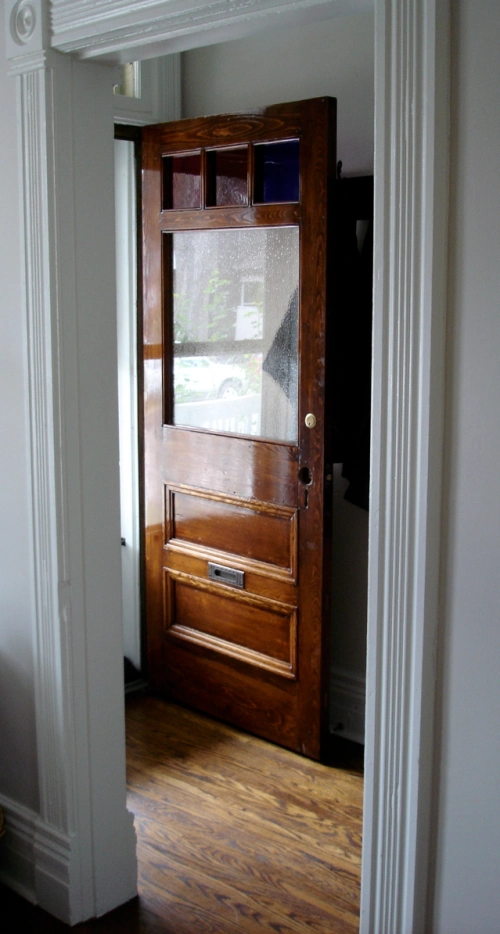The original door on the house is a Queen Anne style that was unfortunately painted with the cheapest grade latex paint. This style of door can be found on many late Victorian Queen Anne styled Bay-and-Gable homes in Toronto.
After some research, Tung oil seemed like the the best possible finish.
Stripping layers of paint off the door revealed a honey pine stain on the exterior and a dark reddish stain that is the base coat on all of the interior wood work. This dark stain was used as the base for the interior Victorian tromp l’oeil faux oak finish. Paint stripping was time and I am loath to even recall the ordeal. I discovered too late that a carpenter in the area would have been able to do the work at a reasonable rate, which I would suggest. Otherwise, you will be working with methyl chloride which is a very harsh chemical that is a VOC solvent and not terribly “green”.
Of course, follow usual guidelines when you suspect lead paint (see post on refinishing hardware). More environmentally friendly chemicals should be used if you are lucky enough not too have too may layers to remove.
I wanted as period a finish that I could achieve and that meant was very reluctant to use a polyurethane. The plastic coated look of polyurethane finishes are not very attractive to my eye.
After some research, Tung oil seemed like the the best possible finish. Tung oil, the oil from a Chinese nut producing tree, has been used for centuries to water protect wood on Chinese sailing junks. The oil naturally polymerizes itself by linking up the molecules into chains creating a beautiful finish that repels water and allows the wood to breath. The finish is not “oily” in the least, is dry to touch and hardens to protect the wood. Best of all, with a light sanding, the finish can be touched up and renewed at any time.
I used Circa 1850 polymerized Tung oil varnish. Polermerized tung oil has been heated to encourage even more molecular cross linking during the curing process and has been traditionally used a Marine Spar varnish on beautiful wood hulled power boats.
Paint was removed using a few specialized scrapers for the moulding. Plenty of steal wool was used to remove paint and old varnish from the grain. This raised the grain of the wood which allows stain to be taken up. The door was sanded with 80 grit paper, then 120 grit paper, then 150 grit paper and finally 220 grit paper.
The 120 year old door had an amazing heart pine grain. Since it was a soft wood, a coat of wood conditioner was applied prior to stain to ensure the stain was soaked up within the wood in an even manner. Three coats of stain were applied allowing 24 hours of drying between coats. Then three coats of Tung oil varnish were applied scuffing the finish with fine steel wool between coats. A visit to the Frick Collection in New York provided the inspiration for our choice of stain colour. Of course, I had to make this enterprize more difficult than it needed to be, but the hue of the stain was perfect, very warm and complemented the golden hues of the aged heart pine of my far more modest door.
The result was better than anticipated and the stain and tung oil really brought out the antique patina of the aged wood.
Antique front doors are a bargain at most architectural reclamation stores. Partly because, many home owners are not willing to take the trouble to either refinish the original door or have a carpenter fit in a suitable antique period door. Nonetheless, the very minor additional effort is worth the results. A big box steel door on a period home is an act that frees space in hell for lost souls. While I had the original door to work with, it can be great fun picking out the perfect door at your local salvage shop.












